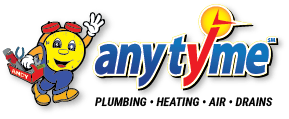What You Can Flush Down the Toilet: Lavatory Lies We’ve All Believed
The toilet: a porcelain throne designed for one purpose, yet used for many. For some, the toilet is a small but necessary part of the day: a quick pit-stop in the middle of a busy routine. For others, the toilet is a place of comfort and relaxation: a seat on which to linger, located inside a room that is sometimes the best option for peace and quiet. While both of these toilet treatments are acceptable, there is one that is not. The time has come to spread the message: the toilet is not a trashcan.
Our plumbing experts here at 1-800-anytyme know it’s important to discuss the toilet and how to use it properly. Toilet users should know which items they can and can’t flush down the toilet, helping you save money and the environment!
Flushing Your Toilet: Where Does the Waste Water Go?
Once a toilet is flushed, toilet water (and everything else in it) travels through pipes on a property that are connected to the city’s municipal sewer system.  Once in the sewer, toilet wastewater goes to the city’s wastewater treatment facility. There, a variety of processes treat wastewater from homes, along with wastewater from businesses, industries, and other properties. This reduces or removes pollutants.
Once in the sewer, toilet wastewater goes to the city’s wastewater treatment facility. There, a variety of processes treat wastewater from homes, along with wastewater from businesses, industries, and other properties. This reduces or removes pollutants.
Wastewater treatment facilities use many methods to reduce and remove pollutants from water. These methods include primary treatments, which involve screening and settling out large particles. All municipal water treatment facilities also employ secondary treatment methods. They use bacteria to remove microscopic organic materials, as well as chlorine to kill off bacteria and disinfect water. Some municipal treatment facilities take things a step further by using a final, advanced treatment process. This reduces the presence of pollutants that are of special concern to the local water body (such as nitrogen or phosphorus). Once treatment concludes, the water pipes back into the local water supply.
Bringing it All Together: Water Treatment, Plumbing, and What Goes Down the Toilet
With modern municipal water treatment facilities in place, it would seem that virtually anything can be flushed down the toilet — after all, it would just filter out, right? Wrong. Even the most advanced water treatment facilities can only filter certain materials out of water. There are other materials, such as many inorganic substances, that will remain in water even after filtration. Further, some substances are simply difficult for water treatment facilities filter out of water—if they even make it that far. Many large, solid objects flushed down toilets can damage plumbing and get stuck in pipes. This leads to expensive repairs and replacements for property owners.
To keep your local water supply clean and protect your plumbing from unwanted damages, it’s vital that you flush only permissible items down the toilet. So what can and can’t be flushed?
Things You Should Flush Down the Toilet
It may surprise the average property owner to read that the list of things you should flush down the toilet is surprisingly small. However, if given just a moment of thought, the “toilet shortlist” makes perfect sense. After all, toilets are designed to do away with human excrement and nothing else. Flushing other items down just doesn’t make sense (and can cause significant damage in a number of ways). The list of things you should flush down the toilet includes:
- Human excrement: The true purpose of a toilet—to do away with human excrement. (This includes both number 1 and number 2.)
- Toilet paper: Toilet paper is a necessary item for many toilet-related duties. It is also fairly easy to filter and is best disposed of by flushing down the toilet.
Things You Should Not Flush Down the Toilet
The above list covers all of the things that should be flushed down the toilet. As you can see, it is quite short. All other items should not be flushed down the toilet. This includes all other liquids and solids — including a vast list of things that may disappear after being flushed.
Do not be fooled: if it disappears down your toilet, it can still cause damage down the line. Below is a list of common items that should not be flushed down the toilet.
- Household products such as cleansers, beauty products, medicine, auto fluids, paint, and lawn care products. Wastewater treatment facilities are designed to treat organic materials. Flushing inorganic hazardous chemicals down the drain can lead to the contamination of your local rivers, lakes, and coastal waters.
- Excess household grease (such as meat fats, lard, cooking oil, shortening, butter, and margarine), diapers, condoms, and personal hygiene products. These materials can clog pipes and lead to costly plumbing repairs. In some cases, they can cause raw sewage to overflow in your home or yard, or in public areas, which can, in turn, lead to contaminated waterways.
- Motor oil and photographic chemicals. These chemicals are hazardous and cannot be completely filtered by municipal water treatment facilities. Their presence in the water supply can lead to severe water contamination.
- Large solid objects. Thinking of flushing your trash down the toilet? Think twice. Large solid objects can often get caught in pipes, leading to costly plumbing repairs and replacements.
Other Toilet and Bathroom Myths
To conclude this guide, we’ll spend a bit of space discussing and debunking several toilet-related myths. Ranging from the weird to the downright dangerous. Believing them could lead to environmental degradation, property damage, and money out of your pocket.
- Myth #1: “Flushable” toilet wipes are okay to flush down the toilet. These wipes may be marketed as “flushable,” but most of them aren’t nearly as biodegradable as toilet paper. They can clog pipes and contaminate waterways.
- Myth #2: A brick placed in the back of a toilet tank will save water. Bricks may take up space —but they’ll also deteriorate over time and cause other things in your toilet to break. The intended effect can also backfire, leading to too much water displacement and a necessity to flush twice.
- Myth #3: Toilet bowl tablets that contain bleach will keep the toilet clean. Cleaning your toilet bowl with bleach may seem like a good idea, but it’s really quite the opposite. Tablets that contain bleach and are designed to sit in the tank will destroy the working parts of a toilet within months. Nobody wants to have to buy a new toilet.
Toilet repairs and replacements From 1-800-anytyme
Even with the best toilet etiquette, accidents still happen. If you have a broken toilet in your home or business, it’s best to contact a professional in your area to address the problem efficiently and effectively. Here at 1-800-anytyme, we are proud to offer toilet repairs and toilet replacements to homes and businesses across the greater San Diego, CA area. Follow the links above to learn more about our professional services and keep reading our blog for helpful posts on leaky toilets and more. Ready to schedule an appointment? Contact our team today!
Sources
What Can You Do to Protect Local Waterways? Where Does the Dirty Water Go? United States Environmental Protection Agency (EPA). December 2002.
